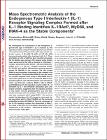| dc.contributor.author | O'NEILL, LUKE ANTHONY JOHN | |
| dc.date.accessioned | 2009-09-29T17:02:38Z | |
| dc.date.available | 2009-09-29T17:02:38Z | |
| dc.date.issued | 2007 | |
| dc.date.submitted | 2007 | en |
| dc.identifier.citation | Constantinos Brikos, Robin Wait, Shajna Begum, Luke A. J. O'Neill, and Jeremy Saklatvala `Mass Spectrometric Analysis of the Endogenous Type I Interleukin-1 (IL-1) Receptor Signaling Complex Formed after IL-1 Binding Identifies IL-1RAcP, MyD88, and IRAK-4 as the Stable Components? in Molecular and Cellular Proteomics, 6, 2007, pp 1551-1559 | en |
| dc.identifier.other | Y | en |
| dc.identifier.other | Y | |
| dc.identifier.uri | http://hdl.handle.net/2262/33436 | |
| dc.description | PUBLISHED | en |
| dc.description.abstract | We investigated the composition of the endogenous ligand-bound type I interleukin-1 (IL-1) receptor (IL-1RI) signaling complex using immunoprecipitation and tandem mass spectrometry. Three proteins with approximate molecular masses of 60 (p60), 36 (p36), and 90 kDa (p90) became phosphorylated after treatment with IL-1. Phosphorylation in vitro of p60 has been reported previously, but its identity was unknown. We showed using tandem mass spectrometry that p60 is identical to interleukin-1 receptor-associated kinase (IRAK)-4. MS also enabled detection of IL-1, IL-1RI, IL-1 receptor accessory protein (IL-1RAcP), and myeloid differentiation primary response protein 88 (MyD88) in the complex. The p60 protein (IRAK-4) was the earliest component of the complex to be phosphorylated. Phosphorylated IRAK-4 from the receptor complex migrated more slowly in SDS-PAGE than its unphosphorylated form as did recombinant IRAK-4 autophosphorylated in vitro. Phosphorylation was restricted to serine and threonine residues. IRAK-4, p36, IL-1RAcP, and MyD88 bound to the liganded receptor within 15 s of activation by IL-1 and remained associated upon prolonged activation, suggesting that the signaling complex is very stable. The p90 phosphoprotein was only transiently associated with the receptor. This behavior and its size were consistent with it being IRAK-1. Our work revealed that liganding of IL-1RI causes its strong and stable association with IL-1RAcP, MyD88, and the previously unidentified protein p60 (IRAK-4). The only component of the IL-1RI signaling complex that dissociated is IRAK-1. Our study is therefore the first detailed description of the endogenous IL-1RI complex. | en |
| dc.format.extent | 254790 bytes | |
| dc.format.extent | 1551-1559 | en |
| dc.format.mimetype | application/pdf | |
| dc.language.iso | en | en |
| dc.publisher | The American Society for Biochemistry and Molecular Biology | en |
| dc.relation.ispartofseries | Molecular and Cellular Proteomics | en |
| dc.relation.ispartofseries | 6 | en |
| dc.rights | Y | en |
| dc.subject | Biochemistry | en |
| dc.title | Mass Spectrometric Analysis of the Endogenous Type I Interleukin-1 (IL-1) Receptor Signaling Complex Formed after IL-1 Binding Identifies IL-1RAcP, MyD88, and IRAK-4 as the Stable Components | en |
| dc.type | Journal Article | en |
| dc.contributor.sponsor | Science Foundation Ireland | |
| dc.type.supercollection | scholarly_publications | en |
| dc.type.supercollection | refereed_publications | en |
| dc.identifier.peoplefinderurl | http://people.tcd.ie/laoneill | |
| dc.identifier.rssinternalid | 50644 | |
| dc.identifier.rssuri | http://dx.doi.org/10.1074/mcp.M600455-MCP200 | |




